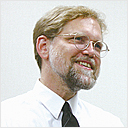Courses
To support active learning including discussions, group work, desktop experiments, media production activities, and many more, KALS can be freely configured depending on the requirements of a class. Also, dedicated KALS staff assists in active learning, integrating it into collaborative learning type classes, and consulting.
KALS can put liberal arts classes based on the active and high-level educational activities of gactive learningh into practice. More specifically, they are the kinds of classes with such activities as students proactively analyze, integrate, evaluate and make decisions through reading, writing, discussions and problem solving in response to the input of knowledge in the forms of phenomena, data, information, videos and so forth and then output the results of these efforts in a systematic way. By not only introducing active
learning in our universityfs proven liberal arts education but also utilizing ICT including tablet PCs, we are promoting such educational activities as students can actively organize their knowledge in a more effective and efficient manner.
Current Classes(A Semester 2023)
| A day of the week | Period | Course Title | Teacher |
|---|---|---|---|
| Mon | 2nd | Active Learning of English for Students of the Arts(ALESA) | TSAI Aurora Marjorie |
| Mon | 4th | Senior Division/Special Seminars of Liberal Arts for Advanced Students(Cognitive Brain Science(Practical) (1)) | Nakamura, Yuko/ Asamizuya, Takeshi/ Koike, Shinsuke |
| Tue | 2nd | Specialized Seminars/Special Seminars of Liberal Arts for Advanced Students(模擬国連で学ぶ国際関係と合意形成I) | Nakamura, Nagafumi |
| Tue | 3rd | German Language | Ishihara, Aeka |
| Wed | 1st | Active Learning of English for Science Students(ALESS) | Berman, Naomi |
| Wed | 2nd | Specialized Seminars/Special Seminars of Liberal Arts for Advanced Students(模擬国連で学ぶ国際関係と合意形成II) | Nagafumi, Nagafumi |
| Wed | 4th | Senior Division/Special Seminars of Liberal Arts for Advanced Students(広域英語圏地域論演習) | Smith, Rodney |
| Wed | 5th | Specialized Seminars/Special Seminars of Liberal Arts for Advanced Students(未来の学びを考える【理論と事例編】) | Nakazawa, Akiko |
| Thu | 4th | Area Studies II | Smith, Rodney |
| Thu | 5th | Specialized Seminars(平和のために東大生ができること) | Okada, Terue |
| Fri | 1st | Humanities Seminar(Data Analysis) | Oomori, Takuya |
| Fri | 2nd | Specialized Seminars/Special Seminars of Liberal Arts for Advanced Students(「オープン教材」をつくろう!) | Nakazawa, Akiko |
| Fri | 5th | Specialized Seminars(駒場で「食」を考える) | Okada, Terue/ Watanabe, Yuichiro |
Classes Using KALS
KALS can accommodate a wide range of liberal arts education classes including human sciences, natural sciences, and language education. In KALS, students can conduct Internet-based simple surveys, group discussions, presentations using ICT, and other activities. The students can share documents and exchange comments online to improve the level and quality of the communication in the class. Furthermore, by using video archive, 3D model, simulation and other types of software, students can understand and interpret in an exploratory manner some phenomena that are difficult to be understood through books.
Life Sciences
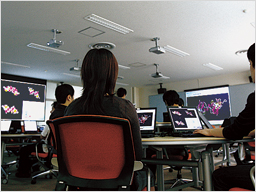
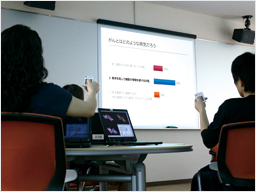
In this course, students are discussing medications for leukemia, which is caused by chromosome abnormalities. Through the use of case studies, these beginning students can grasp the significance of the life sciences and understand more deeply the basic mechanisms of life. The microscopic world is visualized in a comprehensible manner through a rich collection of videos and images.
Since the levels of knowledge and understanding of the students vary, the instructor asks simple questions using the personal response system. By grasping what the students are thinking and their level of understanding, the instructor can provide appropriate explanations. The students participate actively in class and compare their ideas with those of their classmates.
An interactive animation on how a drug suppresses cell growth helps students understand through experiential learning how the medicine is effective.
A three-dimensional computer simulator using the latest data enables students to visualize clearly phenomena at the molecular level that cannot be seen directly.
By comparing and integrating the results of these activities, students come to understand the biological mechanisms through the relationships between macro-level phenomena and the microscopic structure of proteins.
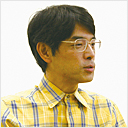
Professor Yuichiro WATANABE
Multi-Disciplinary Sciences Life Sciences,Graduate School of Arts and Sciences,The University of Tokyo
History of Sciences and Technology
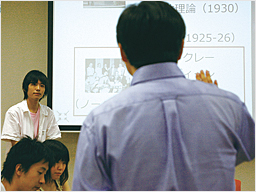

In this course, the invention of the transistor is used as an example for learning how science and technology are related to each other. Choosing from a rich collection of footage stored in the NHK Archives, students can search, watch, and utilize videos as discussion materials for their assignments. This activity is powered by the MEET Video Explorer developed at the University of Tokyo.
This group is focusing on the roles of transistors as electronic devices in comparison with vacuum tubes.
This group is looking into the background of the invention of the transistor, including the countries, places, period, and research institutions.
The last group is tracing the inventors of the transistor and the steps leading up to its invention.
After watching the video footage, each group discusses whether the invention of the transistor was a product of science or of technology. Since students have watched different videos, they can exchange and compare ideas and engage in active discussions from a variety of viewpoints.
Through these learning activities based on high-quality information and discussions, with the invention of the transistor as a starting point, students come to understand how the immediate application of scientific discoveries to technology has become common in the modern world.

Associate Professor Takuji OKAMOTO
Department of History and Philosophy of Science,Graduate School of Arts and Sciences,The University of Tokyo
English Academic Writing
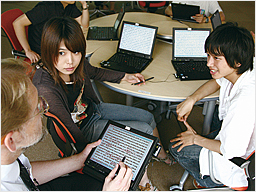
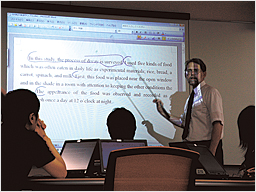
By writing papers in English, students in this class learn to organize their ideas logically and to improve their presentation skills. Rather than the instructor lecturing on how to write papers, the students go ahead and write their ideas in the form of academic papers.
Through the networked computers, the instructor can assess in real time what each student has written. When a student needs to make revisions, the instructor can project the text onto the large screens or the interactive digital whiteboard and offer instant advice how to express ideas more logically.
In order to learn how to write using academic methodologies, students work in groups to search for information and to write reports based on their findings.
In addition to the hands-on experience with writing logically, the group discussion and composition helps students learn from each other’s perspectives and reflect on their own ways of thinking.
By reviewing their writing and thought processes in the classroom itself, the students develop skills for both academic writing and analytical thinking.
